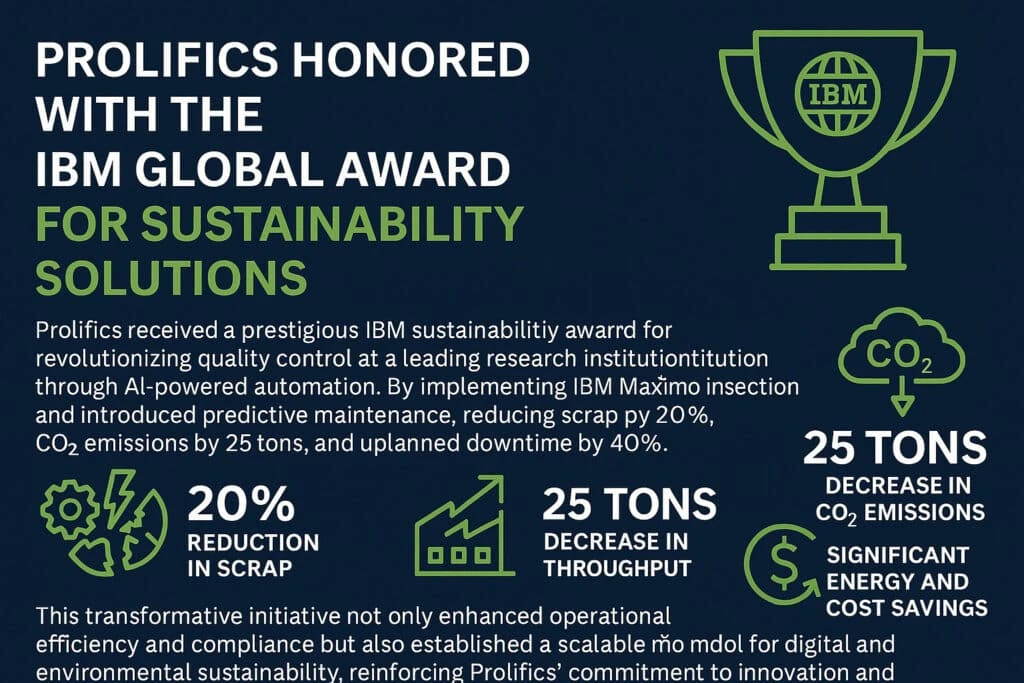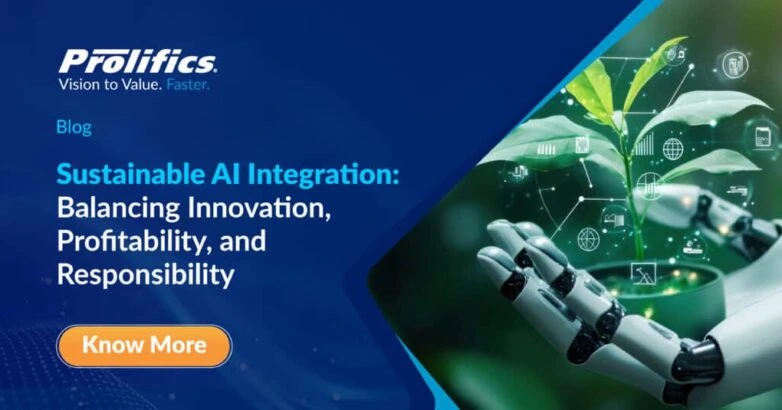Artificial Intelligence (AI) has emerged as the defining force in digital transformation. Yet, as enterprises accelerate their AI adoption to remain competitive and unlock efficiencies, a critical question arises: Can Sustainable AI Integration be powerful and sustainable?
At Prolifics, we believe the answer is a resounding yes when designed and deployed with intention. Sustainable AI Integration isn’t just about reducing environmental impact; it’s about embedding ethical, equitable, and energy-conscious practices across the AI lifecycle while still driving business growth. This balance between profit and responsibility quickly becomes the new standard for modern enterprises.
The Imperative for Sustainable AI Integration
AI systems, especially those powered by large-scale models and deep learning architectures, are resource-intensive. Training a single large model can emit as much carbon as five cars over their lifetimes. Add to that the growing demand for real-time inference, and AI’s carbon footprint is rapidly expanding.
However, true AI sustainability goes well beyond carbon emissions; it encompasses a broader, more holistic approach that includes:
- Energy efficiency
- Supply chain impact
- Data governance and fairness
- Workforce reskilling
- Ethical algorithm development
These principles emphasize a value-aligned approach, ensuring AI solutions serve long-term societal goals while remaining commercially viable.
Building Blocks of Sustainable AI Integration
With these foundational pillars in place, businesses can begin to unlock the tangible benefits of sustainability. How to implement sustainable AI integration in enterprises demands a multi-dimensional approach. Here are the core elements organizations must consider:
1. Energy-Efficient AI Infrastructure
Optimizing AI infrastructure is the first step. Cloud-based AI environments, when configured with green energy sources and advanced workload management, significantly reduce emissions. Leveraging edge computing can also reduce the need to transmit large volumes of data, further minimizing energy use.
Prolifics helps enterprises select and configure cloud-native platforms and AI models that are energy-optimized, balancing speed and performance with carbon efficiency. This is central to energy efficient AI models for business growth.
2. Green AI Models
Choosing or training leaner models without compromising accuracy is another crucial sustainability lever. Instead of defaulting to large, complex models, businesses should consider distilled, smaller architectures, automated model pruning, or transfer learning where possible.
Our AI experts specialize in model optimization techniques, ensuring your AI projects not only perform well but also consume fewer computational resources, supporting energy efficient AI models for business growth.
3. Ethical Data Practices
Ethical data practices in artificial intelligence projects are essential, ensuring that data used in AI models is ethically sourced, diverse, and bias-aware. Poor data practices can reinforce systemic inequality and erode stakeholder trust.
Prolifics supports organizations in establishing robust data governance frameworks that include bias detection, explainability, and transparent data sourcing protocols.
4. AI Lifecycle Management for Sustainable Innovation
From ideation to deployment, AI models must be monitored, retrained, and retired responsibly. This calls for a lifecycle strategy that anticipates model drift, fairness decay, and changing user behavior.
AI lifecycle management for sustainable innovation also opens the door to circular innovation, where models or data assets can be reused across domains, reducing the need for duplication and lowering resource demands.
5. Responsible Workforce Transformation with AI Adoption
AI adoption often leads to workforce restructuring. A sustainable approach involves reskilling and upskilling programs that empower employees rather than displace them.
Prolifics partners with clients to design AI-augmented workforces, blending human creativity and machine intelligence for scalable, sustainable outcomes. This is a key part of responsible workforce transformation with AI adoption.
The Business Case for Sustainable AI
Companies integrating sustainability into AI initiatives are reaping measurable returns:
- Cost savings through energy efficient AI models for business growth
- Improved brand reputation with customers and regulators
- Increased AI adoption due to improved trust and fairness
Talent retention through ethical innovation and upskilling
Prolifics’ Approach: Embedding Sustainability into Every Layer of AI

Prolifics empowers businesses to navigate this complex intersection of AI and sustainability through:
- AI Sustainability Assessments: Auditing your current AI footprint and identifying optimization opportunities.
- Carbon-Aware AI Design: Choosing algorithms, platforms, and training techniques with sustainability built-in.
- Ethical AI Toolkits: Deploying bias detection, model explainability, and ethical data practices in artificial intelligence projects.
- Sustainable Cloud Integrations: Migrating to green cloud providers with low-emission data center footprints.
- Upskilling for Sustainable Innovation: Preparing your teams to manage and govern AI responsibly, supporting responsible workforce transformation with AI adoption.
Conclusion: The Future of AI is Responsible, Not Just Intelligent
In a world shaped by climate urgency, rising energy costs, and growing consumer scrutiny, AI cannot afford to operate in isolation from sustainability goals. The most successful organizations will be those that see sustainable AI Integration not as a constraint, but as a competitive advantage, a way to innovate responsibly, reduce risk, and drive enduring value.
At Prolifics, we don’t just build intelligent systems, we build ethical, efficient, and enduring AI ecosystems. If you’re ready to accelerate your digital transformation while committing to environmental and social stewardship, we’re ready to guide you. Contact our AI sustainability experts for a tailored assessment today.
Discover how a top research institution transitioned from manual processes to cutting-edge machine vision, driving precision, sustainability, and efficiency.
Download the Case Study: From Manual Inspection to Machine Vision
Uncover how sustainable AI integration is reshaping quality control for long-term impact.




